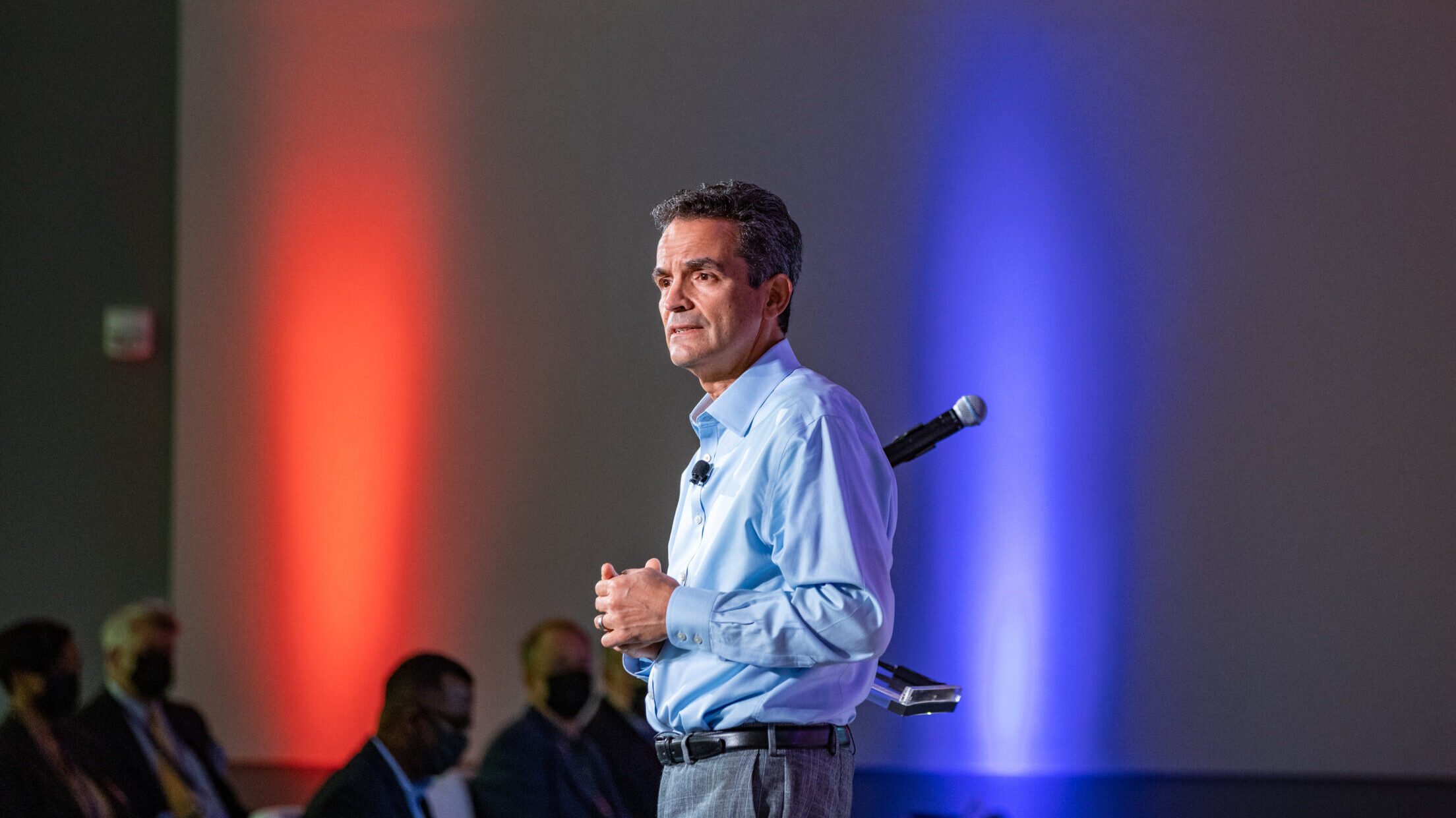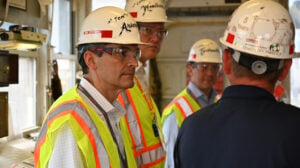
BAE Systems Inc. CEO Tom Arseneault. (BAE Systems)
WASHINGTON: It was a phrase that defense experts throughout the Washington area started using in earnest following last November’s election — “flat is the new up.”
While the Trump administration had delivered major spending increases for the Pentagon, the military’s projections for fiscal year 2022 were essentially flat. With the Democratic administration of President Joe Biden coming in with a domestic focus following the COVID-19 pandemic, the assumption in the defense community was that even staying flat would be a win for the military’s budget.
Except a funny thing happened: the Democratically-controlled Congress stepped in and increased spending in the National Defense Authorization Act by $25 billion. That increase was a strong sign for Tom Arseneault, the CEO of BAE Systems, Inc., to start to breathe easier about where defense spending may be headed.
In an exclusive interview with Breaking Defense, held during the Reagan National Defense Forum earlier this month, Arseneault described himself as “cautiously optimistic” about spending levels moving forward.
“With all of the expense of the coronavirus and our response to it as a nation — that costs money. So I think many of us assumed we’d be heading into a flattening, if not modestly declining, budget,” he said. “It was a big surprise to many that Congress decided that ‘hey, we actually need to increase this budget by $25 billion.’ That was unexpected, but it’s a sign that the threat is real, and that it is of a magnitude and sophistication that requires this kind of budget action.
“And so I hope that portends to FY23, an improvement in FY23 and beyond, but that remains to be seen.”
RELATED: A potential full-year CR? Here’s what defense leaders are saying
While waiting for a final budget to be worked out in order to avoid a full year continuing resolution — “If I had to guess I think we’re gonna be able to come to a conclusion before then,” Arseneault said — he went into detail about how the company is dealing with the COVID-19 fallout, potential merger and acquisition (M&A) activity to come, and how BAE Systems is adjusting in the era of JADC2.
This interview was conducted Dec. 4, before the Pentagon paused the requirement of contractors to have their workforces vaccinated. It has been condensed for length and edited lightly for content.
The Pentagon is just a couple months, if not weeks, away from releasing its new National Defense Strategy. Are you concerned that there will be big shifts that impact the business, or are you expecting things to stay largely in line with the previous version?
Yeah, I think it’s the latter. What’s different about where we are today, and with these threats, China and Russia in particular, is these are long-play threats. These are not, this is not the typical, you know, maybe more asymmetric warfare that we’ve been in for the last couple of decades, really. And although, one would point out that we’ve been at war in Afghanistan for 20 years, the combat dimensions of that were much shorter — the fielding of new equipment and the levels of sophistication of equipment were different for that sort of scenario. This is about building capability with highly sophisticated adversaries that — it’s going to take time and staying power. And so I think that the strategy will reflect that and budgets, hopefully, will as well.
Let’s talk about JADC2, because it’s the hot phrase around the Pentagon right now. From where you sit, what has been the reaction to JADC2 in industry? Has it been taken seriously or do you think it’s been looked at as kind of a passing fad, as we’ve seen before?
Yeah, I think a little of both. I mean, JADC2 as a concept, the elements of it have been around a long time. There’s been versions of this that have been, kind of, trotted out and thought about for decades, really. And you know, at its core, it’s about creating this interconnectivity that then enables interoperability to a level that’s never been done before. But, what’s different now, and it comes back to the threat, is that much more important [having an] enabler, given the sophistication of the threat. It would have been a really nice thing to have in the Middle East or Afghanistan, but now in this sort of world order, you know, it’s that much more important. There are those that view a lack of that as an existential threat. And so, what does it mean to industry? Well, one of the things about JADC2, or all the other names — multi-domain operations…
Which is part of the problem, right? It’s got so many different names and forms associated with it.
There’s this sort of service branding that goes on around that, which is fine. But, you know, it’s not like a [single] program, right, that somebody is going to go off and compete for a program called JADC2. JADC2 is an environment that we all will need to contribute to in one form or another. It’ll have, by its very nature, the need for the connectivity dimension of it, which will be networks and communications and secure avenues of digital sharing.
But then, for many of us who build systems that operate in these environments today, it’s about being able to — if you could walk up and plug in a Cat 6 connector, what features would that system need to have that would be useful in and could enable this interoperability. And so that’s the way we’re thinking about it, is how do we take the systems we have today and get them to graduate to be able to be part of the JADC2 world?
It seems like BAE Systems would be well placed, given your portfolio, for this kind of concept, but with that comes pitfalls. You could end up investing a lot of energy and money into it and have the Pentagon change its mind about the concept. How do you negate that risk?
Yeah. So, start with the Pentagon — I mean, we try to stay as plugged in as we possibly can with all the thought leaders in the various services. And, you know, they’ll admit that even in their own right, it’s hard to get the services all aligned, right? One of the things about, when something begins with a ‘J,’ there’s another degree of difficulty that comes with it. And I think they all recognize that. They recognize that interoperability will require cooperation, collaboration over time. And so we’re tracking that. And that’s a little bit of [of where] some of the skepticism from outside is, “Can we all work together in a way that turns this into reality?” You know, on the portfolio side, we’ve got communications, those will play in by definition. And then you look at some of our areas of strength — electronic warfare, there is so much that can be brought to bear when you network electronic warfare across platforms. [GPS] the need for precision, interoperability demands reliance on precision that is helpful. And so being in the military GPS businesses is a good thing.
And so because we have the luxury and honor of being on so many different platforms today, many with common elements of architecture, there is an unleashing of capability when we get to a point where JADC2 is a reality.
Do you expect to see greater merger and acquisition efforts in the coming years, across the industry?
Again, I think the threats we face, the long strategies need to play here. I think there’s not going to be an appetite for large scale M&A in in the defense industry, but I think to the extent there are good ways to plug smaller pieces in and help build a bigger and better whole, and maybe bring the benefit of some of the ways to accelerate integration of some technologies into systems already, that will continue.
JADC2, to go back to that for a minute, there will be the need to be able to simulate things on a much grander scale, right? The cost of doing massive operations jointly is very high and to the extent we can, in a high-fidelity way model that interoperability, I think that brings benefit to sort of the war-gaming side of things as well as training and so forth. So that that was the thinking there. We continue to look for those sorts of opportunities.
Are there any areas you’re keeping an eye on for potential M&A bolt-ons to BAE Systems?
Well, I mean, it’s all the things you would expect, right? Things to do with hypersonics, hypersonics defense, and space — we’ve been in in space for decades. We do radiation-hardened microcircuits and processors on the Mars Rover, on any number of spacecraft and satellites. A lot more demand there. And we’re positioning to help with that as well. And so, you know, again — it’s in the areas where the priorities of the National Defense Strategy would dictate.
Business-wise, what’s something you are really keeping an eye on?
What’s the thing that we should all be worried about the next year? It’s workforce, I think. I think we’re at a point in time — and things like the vaccine mandate just tend to shine a light on it, and COVID in the way it’s moved us into this need for more hybrid workforce and so forth. There is a tectonic plate shift there in the way that the defense industrial base workforce thinks about their jobs. And couple that with maybe a spike in retirement as people consider where their retirement nest egg has done pretty well here over the course of the last couple years, their real estate that they’re sitting on has done pretty well, and so I think we’re all feeling that. STEM isn’t, as much as we’ve been trying to continue to push that — I think there was a quote, around there will be the need for three and a half million jobs 2025 in the STEM field, and the current estimate of supply is about a million and a half. So that’s a big problem. That’s one of those that keep you up at night.
Is this more a concern with the skilled labor of people who are actually physically building things, or with the design engineering aspect of it?
It’s both. I mean, even on the manufacturing side, we’re moving more digital, it’s more about programming the automated system that you would otherwise be doing manually. So those jobs are getting to be higher and higher tech as well. So STEM transcends the traditional design-manufacturing divide.

Tom Arseneault, BAE Systems Inc CEO, tours a production facility. (BAE Systems)
Obviously we hear non-stop talk about supply chain issues, particularly when it comes to the kind of electronics which would go into an EW system. What impact is the supply chain having on your products?
For us, thankfully, much of the more sophisticated elements of an EW system have to do with, you know, sort of complex microwave devices. We make those ourselves; we have our own foundries where we do some of that work ourselves. Now, that said, we are dependent on microelectronics in a broader way. You know the whole story: supply and demand in the wake of COVID sort of got knocked off kilter, automotive industry, etc, etc. And so, next thing you know, semiconductor manufacturers are in a bind, trying to come back up to speed. We, through a combination of long term supply agreements and just, you know, [being] lucky building up inventory, in the wake of COVID we’ve been able to weather that a bit. But, you know, to the extent it continues for any length of time, it’s gonna affect everybody.
Some of the efforts of this administration and previous ones, to think about how do we onshore — we are too dependent on offshore capabilities, how do we onshore some of that — we just signed out a letter with 58 other CEOs for the CHIPS act and FABS Act, which are to support, design, research and manufacturing capabilities and semiconductors back here in the states. We’re teamed with Intel and a number of other semiconductor manufacturers in order to make sure that the defense industrial base plays a role in that as well. And so we’re trying to help solve the problem at its source, and then in the meantime, you know, work every angle we can to keep the source of supply moving forward into our products,
Beyond microelectronics, are you still feeling the impact from COVID?
Oh, yeah. Let’s face it, COVID rocked the world, no doubt about it. In the early going — and this won’t be news, obviously — but we recognized the need for cash flow all the way down to the supply chain, particularly into the smaller companies. So we worked through AIA and others to get progress payments, Section 3610, these kinds of things in place in order to help them weather the storm. Now the storm has lasted a really long time. We’ve got a new challenge in the form of the vaccine mandate, which, maybe surprisingly, maybe not surprisingly, is not met with 100% advocacy. And in a really large company where you can move resources around, we can work through that. Smaller companies, you know, depending on where they are and what their profile is, I think they’re feeling this as well.
So, add that to all manner of ripple effects from COVID — just logistics, getting things shipped, has been an issue. We brought in a chief of procurement a couple of years ago, and that did a really good job to make sure we understood our global supply chain where the strengths and weaknesses were, set up some long term agreements where we needed to. And so we’ve, you know, we’ve been able to weather it but we are feeling it. So is everyone.
You mentioned that as a big company, you can shift things around to cover if people quit over the vaccination requirement. Does that mean you’re more concerned with the work force at the second, third and fourth tier suppliers?
Well, I’m concerned about everything. We’re feeling its impacts. I think we’re right on the verge of [mid-90% vaccination rate], adding more every day, but we will get to a point where there’ll be some percentage, hopefully small, of the population who will not comply. And so we’re working with the administration, with DoD, to find ways to try to create some flexibility and maybe buy a little bit more time so that we can either find ways to backfill those resources or get them over the hump.






















